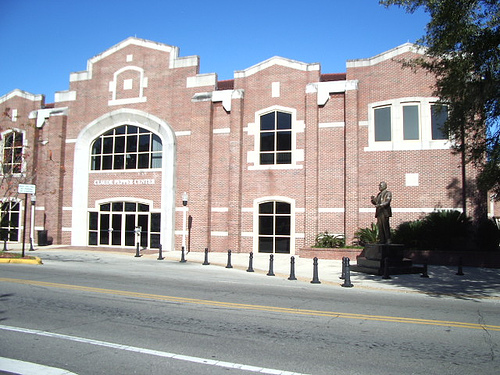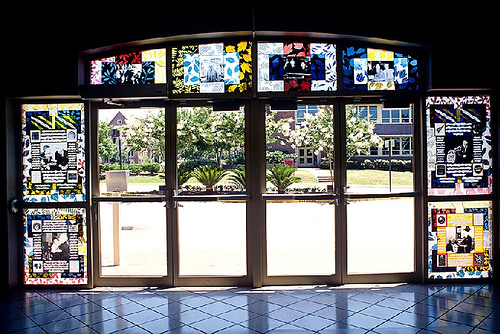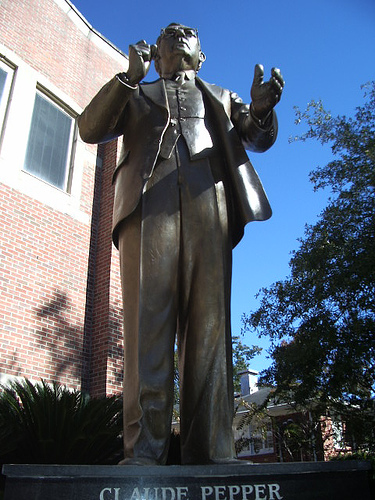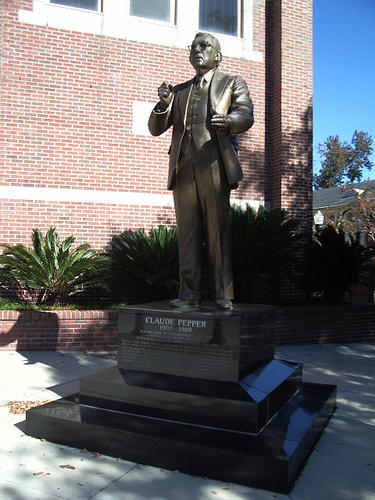|
|
|
The Claude Pepper Center
by Shannon Calloway

|
A
surprising
number of FSU students have never stepped foot inside Strozier Library. Does it come as a surprise, then, that so few
know there is a fully- functioning museum on campus?
The Claude Pepper
Center
is a building
familiar to most students, at least in name, but having little to no
impact on
their daily lives. The mysterious
building with its stained-glass windows, perched behind a brooding,
bronze statue
of some old white guy (an 8’2” likeness of Pepper himself) is, in
actuality, a
museum, archive, and library. All three
are entirely dedicated to preserving the legacy left behind by the late
Claude
Pepper.
|
After serving 40 years in Congress,
Pepper is most famous for sponsoring lend-lease during World War II and
as a
champion for the elderly. From his rural
beginnings in Dudleyville, Alabama and beyond an education at Harvard
Law,
Claude Pepper fought in the US Senate from 1936-1951 and House of
Representatives
from 1963-1989 for the rights of the American people, regardless of
race or
social status. (1) That is his legacy, and
when the Claude
Pepper Foundation collaborated with FSU to create this memorial,
that is what they intended to preserve. (2)
The building itself is a simple
brick structure. Inside is a museum
about Pepper’s life and political career, the complete Library and
Archives
which Pepper donated to the Foundation; the Broad Auditorium, the
Pepper
Institute on Aging and Public Policy, and various offices and
conference
rooms. The entrance to the building is a
striking and vibrant stained glass window created by glass artist Nancy
O’Neil. The window is an assortment of
color and media presentations; with photos, excerpts from speeches and
documents,
and other related memorabilia. It is
organized into four large panels, each centered on a different issue
that was
of high importance to Pepper: the Elderly, laborer’s rights, civil
rights, and
health care. Across the top o the door
are four panels each with a picture of Pepper during a different stage
of his
life.

 |
Greeting
visitors as they approach
the center is the aforementioned bronze statue of Claude Pepper. It was commissioned in part by the Claude
Pepper Foundation, and also funded by the private investment of the
late
Margaret Mosher of California.
(3) The likeness was sculpted by Neil
Estern who
also sculpted the Franklin Delano Roosevelt Memorial in Washington, D.C. Estern
was a fitting choice as the sculptor
for that reason. Not only was Pepper a
friend of Roosevelt and a strong
supporter of
the New Deal, but he pushed Congress to fund the construction of the
FDR
memorial(4). The Pepper statue was
unveiled on November
14, 2003 in a ceremony with both Senator Bill Nelson and FSU President
T.K.
Wetherell present.
|

|
The statue bears
a striking
resemblance to the late senator; captured in the midst of what seems to
be a
passionate address. Estern says about
his sculpture, “I want those who knew him personally as well as those
who know him
only by reputation to immediately recognize the man for who he was and
what he
stood for.(5)” Estern’s choice to depict
Pepper in such a
state is a fitting visual display of Claude Pepper’s legacy. Although his congressional record is not
perfect, Claude Pepper supported the rights of the American people
through his
service in the Federal and State government. Often
accused of being “liberal” and
“radical”, and even accused of
communism in the 1950s,
Pepper’s legislation and speeches (like the one he is presumably giving
in this
statue) advocated the equal rights of every American.
(6) As the monument is meant to promote a
positive image of Claude Pepper as champion of the average American,
the statue
is a fitting and appropriate rendition.
(1) Claude
Denson Pepper. Pepper, Eyewitness to a Century. San Diego:
Harcourt Brace Jovanovich, 1987.
(2)“Unveiling
of the Claude Pepper Statue”. Program from
statue dedication. November 14, 2003
(3)“Pepper
Statue Unveiled”, available on the web at
www.claudepepperfoundation.org/new.cfm.
(4) “Pepper
Statue Unveiled”
(5) “Unveiling
of the Claude Pepper Statue”
(6) Pepper
|
|
Photographs by Shannon
Calloway
|

